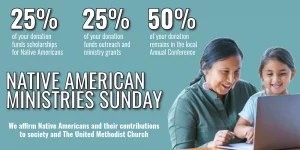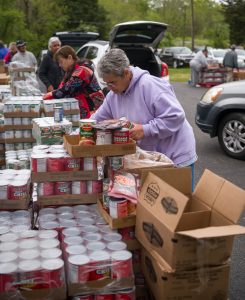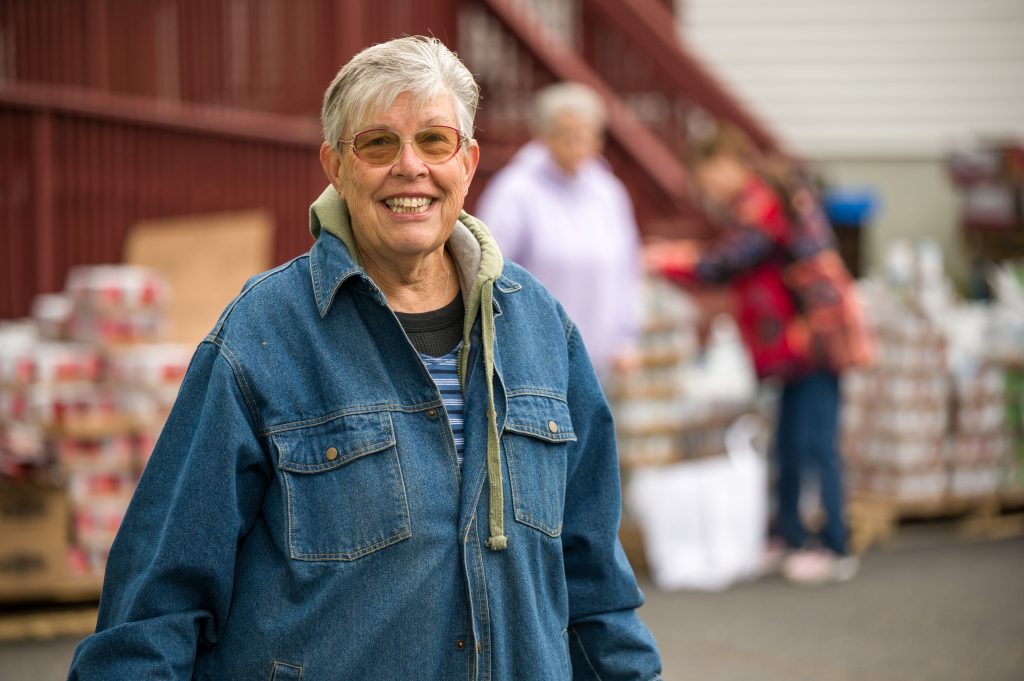Cynthia Mosley (Nanticoke Lenni Lenape), acting chairperson of the Greater New Jersey Conference Committee on Native American Ministries (CoNAM) and a conference trustee, will participate in another video acknowledging Native land origins, to be shown—like in 2023—during the opening of both EPA’s and GNJ’s annual conferences in May. Members of the Eastern PA Conference CONAM will join her in that video.
 Meanwhile, GNJ churches will receive the annual, special offering on Native American Ministries Sunday, April 14. Their gifts support both GNJ’s CoNAM and other Native American ministries in urban, rural and reservation communities around the U.S., plus provide much-needed scholarships for Native seminary students preparing to serve their churches.
Meanwhile, GNJ churches will receive the annual, special offering on Native American Ministries Sunday, April 14. Their gifts support both GNJ’s CoNAM and other Native American ministries in urban, rural and reservation communities around the U.S., plus provide much-needed scholarships for Native seminary students preparing to serve their churches.
Mosley reminds churches that CoNAM can provide speakers or materials to help interpret important Native American concerns, including the human rights crisis of Murdered and Missing Indigenous Women, the history of the Nanticoke Lenni Lenape nation and the Methodist Church in Cumberland County, and the role and impact of Methodist operation of Indian boarding schools.
Celebrating tribal heritage of those who stayed
Native American tribes in New Jersey date back over 10,000 years, she reports. While many tribal members remained on their homeland, the 1830 Indian Removal Act required most to move west of the Mississippi River. Some migrated on a long walk to Oklahoma, while others settled along the way in Ohio, Wisconsin, and Indiana and other territories.
Some Native Americans refused to go and instead, hid “in plain sight” or assimilated into other racial-ethnic groups, all the while preserving their heritage.
St. John United Methodist Church in Bridgeton, founded in 1831, was a sanctuary for those who stayed, Mosley recalls. Following laws that required separation of church and state, state governments allowed Northeast tribes to gather and conduct their ceremonies, sell their goods, worship, and meet their mates.

Corbin Payne photo
Mosley a leader and 55-year member of St. John United Methodist Church in Bridgeton, an interracial, largely Native American congregation, invites all to attend fascinating celebrations of its heritage and traditions on fifth Sundays. St. John also feeds its community by distributing healthy food to hundreds several times a month.
The highly regarded community ministry has won much recognition (See “Church awarded as community’s beacon of ‘Hope’”) and recent grants. The Community Food Bank of New Jersey (CFBNJ) awarded St. John $56,000 in January to help it “increase our distribution of fruits and veggies,” said Mosley, who coordinates St. John’s food ministry. “We are a healthy pantry that addresses increasing diagnoses of diabetes, hypertension and other heart disease and obesity among our people. We are going to remarket our produce giveaway as a farmstand.”
CFBNJ awarded similar capacity-building grants to a number of other United Methodist churches.
Collaborating to provide healthy venison
Nanticoke Lenni Lenape elders and tribal members have a legacy of traditional foods and practices, including hunting and eating venison. In 2021, the Nanticoke Tribal Council and St. John UM Church collaborated with The Food Trust, a nonprofit organization focused on nutrition security, and the New Jersey Department of Health through a SPINE (State Partnerships Improving Nutrition and Equity) grant, to learn from tribal members about their food and health concerns.
Liz Munson, the tribal elder who conducted interviews, identified a strong desire for more traditional foods, including venison, which was not readily available in the community.
 New Jersey Hunters Helping the Hungry, a statewide group, helps hunters donate the deer they harvest, after the deer are dressed and packaged by a licensed and inspected butcher. Local hunger programs, including CFBNJ, work with the butchers to distribute the meat. Mosley reached out to CFBNJ to request venison for local tribal elders, an effort that took months to arrange with help from Michael Schrob, head of CFBNJ’s local food purchasing.
New Jersey Hunters Helping the Hungry, a statewide group, helps hunters donate the deer they harvest, after the deer are dressed and packaged by a licensed and inspected butcher. Local hunger programs, including CFBNJ, work with the butchers to distribute the meat. Mosley reached out to CFBNJ to request venison for local tribal elders, an effort that took months to arrange with help from Michael Schrob, head of CFBNJ’s local food purchasing.
Throughout the summer, Cyndy asked local hunters to donate their harvest. When he received a call that 450 pounds of venison were available, Schrob drove to North Jersey to pick up the venison and brought it to St. John, just a week before Thanksgiving. Cyndy and her volunteers worked hard to make space for the meat, along with the hundreds of turkeys they were providing to the community.
The church successfully distributed the venison from 14 deer to tribal elders and the community. As word spread that venison was available, people contacted Mosley to ask for more. Many elders feel that today’s food is too processed, she said, and that deer is a symbol of the healthy, more natural food of their younger years.
The elders believe that the high rates of diabetes and hypertension in Native Americans is due to the diet switch away from their more natural menus. Since receiving the venison, they have made venison chili, stew, burgers, tacos, meatloaf, spaghetti sauce and meatballs, and even venison jerky.
The deer season ended in late November, but St. John was fortunate to receive additional meat in mid-December. The church is already planning for next year’s distribution, to begin as soon as the hunting season opens.
Main photo: Cynthia Mosley leads food distribution at St. John UMC Bridgeton, NJ. Corbin Payne photo
Some of this article was written by Cynthia Mosely for the Food Trust.

